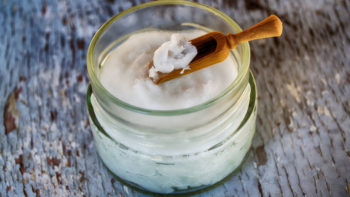The foods you eat can generally be categorized as building blocks or fuel—they help to continually rebuild the cells that make up your body, they’re used in important physiological processes, or they are stored as energy.
This goes not only for protein, carbohydrates and fat, but also cholesterol, vitamins and minerals.
There are so many reasons that each of these elements is important, and today we are going to talk about fats as energy—how it’s stored and how it’s used. (You can watch the video above if you’d rather listen than read.)
There are many types of fat out there. You might be familiar with the monikers of “good” fat and “bad” fat. They basically break fats down into unsaturated fats (the good guys), saturated fats (the questionable fellows), and trans fats (the bad guys).
The “good” fats are the fats that you typically get from things like nuts, seeds, olive oil, fish and avocados. Generally speaking, they’re not going to do you any harm. Though they also include the industrial seed oils, like canola and corn oils, which oxidize quickly and should be avoided or eaten in moderation.
The “questionable” guys, the saturated fats, aren’t bad on the whole, but can be harmful if eaten in large quantities. They include the fats from red meats (yes, pork is a red meat), butter and other dairy, even coconut oil. They are useful as components of various tissues in your body, including your brain, cells and organs, but are also associated with greater weight gain and triglyceride levels. Your body doesn’t need a terribly large amount of them, but they shouldn’t be removed entirely from your diet.
The “bad” fats are the trans fats. While there are technically trans fats occurring naturally in many foods, this generally refers to the fats you find in processed foods and hydrogenated fats.
While these are good to know, we’re going to talk today about how you store and use fat, specifically looking at the phenomenon of MCT oils, what they are, and how they’re used by your body differently from other fats.
When you eat fat, it gets broken down in your stomach and your intestines using compounds from your gallbladder, your pancreas, and the cells lining your intestines. By the time your intestinal cells are done with the fat you have eaten, it’s been packaged up into water-soluble bundles you know as triglycerides, which is the form they’re in as they travel through your bloodstream.
This means that the picture you might have in your head of butter or bacon fat “glooping” through your arteries and clogging them up isn’t quite accurate.
Fat is stored mostly under your skin, but also on and around some organs, as well as in your liver and muscles. One of the things you might have noticed is that men and women store that subcutaneous (under the skin) fat in different places. Men in the chest, belly, and butt, and women in their breasts, hips and waist, and butt.
When you eat, your pancreas is signaled to secrete insulin. Insulin helps cells to absorb glucose, fatty acids, and amino acids. It also tells your cells to stop breaking down its stored energy and to start turning the energy being transported into storage forms (glycogen for glucose, fat for fatty acids, and protein from amino acids).
As long as you’re eating moderate amounts of food and not overeating sugar and refined carbohydrates, this process of storage isn’t a path to being overweight. This is like your checking account. Fat goes in so you can hang onto the energy you don’t need right now, but you can also pull it out and convert it to energy as you need it—like when you’re not eating or you are exercising.
Your body is going to use glycogen first. It’s in the muscles and can be quickly converted at the moment the muscle needs to move. Fat is next, broken down into fatty acids, and, if you need glucose (for your brain for example—your brain can only use fat or ketones for energy), and don’t have stored glycogen, your body can make its own glucose from amino acids in a process called “gluconeogenesis.”
Here is where we could veer into a conversation on ketones and ketosis, but we’ll save that for another time. Short story is that your body can use stored fat to make ketones that serve as energy for your body and your brain. This spares your muscles, especially when fasting. The reason some people lose muscle when undereating is that they never enter into ketosis and their body’s only source of glucose for the brain is amino acids—from your muscle tissue.
Back to fats.
Different dietary fats go on different paths. This is where MCT oil comes in. MCT stands for medium-chain triglycerides.
A triglyceride, which is a fat vehicle, is made up of three (that’s your “tri”) fatty acid molecules connected to a glycerol. The “chain” length refers to the number of carbon and hydrogen atoms trailing off of the end. They range in length from 6 to 21.
The MCTs have a chain length between 6 and 12 and are found in things like coconut oil, palm oil, and goat milk.
MCT oils became more popular with the rise of the ketogenic diet. That’s because these medium chain triglycerides provide a fast source of fat energy that can help your body stay in a ketogenic (which just means “making ketones”) state.
But this doesn’t mean that you have to be eating a ketogenic diet to take advantage of the benefits of MCT oils—energy, weight loss, hunger suppression, and brain function. Most people eating a western diet don’t get enough MCTs, mostly because of the vilification of all saturated fats.
Just because the medium chain triglycerides contain the molecules that range from 6-12 in length, even those don’t all act the same.
The gold standard for MCT is the 8 and 10 length molecules. Some studies have shown that those MCTs cause your body to burn fat, even if you’re not eating a ketogenic diet. You body will turn these into ketones, bypassing the fat storage pathway. That’s the important thing here—fat, as energy, without storing it first.
This creates a rapid source of energy for your body and your brain, but also increases your metabolism, causing your body to burn more of its stored energy, including fats.
Longer chain triglycerides are shuttled into the fat storage process; however they too are converted to ketones when your body converts that fat as energy.
The ketones that are produced by your body when you consume MCT oils also stimulate a hunger-suppressing hormone called ghrelin. That means that your body will stop telling you you’re hungry so often when you consume MCT oils.
Finally, those ketones that get created are a great source of energy for your brain, meaning you don’t have to consume a carb-loaded breakfast in order to ensure you’re getting glucose for your brain to function. Your brain works, for the most part, off of glucose. But it loves ketones, and MCT oils can provide a boost of energy for your brain.
So if you’ve been wondering why people are putting MCT oil into their morning coffee in lieu of eating breakfast, you now have some idea—it provides quick forms of energy and helps them feel full, while burning fat to boot.
Now going a little deeper, we can talk about the different lengths and why people just don’t consume coconut oil as opposed to a concentrated form of MCTs.
The C6 chain, called caproic acid, converts rapidly to ketones, but there is very little of it in coconut oil. It also has a tendency to upset your stomach and tastes pretty bad, so is distilled out of MCT oils you buy in the store (hopefully).
The C8 chain, caprylic acid, is a quick source of ketones, but still only makes up about 7% of coconut oil. When I say quick, consider that your body has a 26-step process to make energy from sugar. C8 becomes ketones in 3 steps.
The C10 chain, capric acid, is also only about 7% of coconut oil. It takes a little longer to make into energy, but is also a little less expensive to make, meaning a combo of C8 and C10 is a less expensive alternative to pure C8 oil.
The C12 chain, lauric acid, while technically an MCT, is not treated like an MCT by your body. It’s also 49% of coconut oil. If you want lauric acid, you can eat coconut oil, but many MCT blends also contain a good amount of it. (And you do want it—it’s a saturated fat that is not associated with cardiovascular disease and is a strong antimicrobial.)
Anything longer than 12 is an LCT—Long Chain Triglyceride. These also exist in coconut and many other oils, but they don’t have the same benefits of the C6–C10 chains.
You can begin to see why, if you want to consume fat as a raw source of energy, you would use MCT oil instead of coconut oil. Only 14% of the coconut oil you might consume is made up of MCTs—you’re simply not going to get enough of the good stuff just by eating coconut oil. The rest is fat you’re going to store rather than use immediately.
Now lest you think you can only put MCT oils in your coffee, think again! You can use MCT oil in salad dressings and add it to things like smoothies or oatmeal. If you want to incorporate MCTs in your cooking, coconut oil is a better option as it has a higher smoke point.
If you’re comparing MCT oil to powder, just consider a few things—oils can be tough on some people (just consider the side effect known as “disaster pants”) and powders make it possible for people who struggle with the oil to get MCTs into their diet.
When buying powder, just make sure you can find what it’s made of:
- Is it mostly C8 and C10? How much C12 is it? You don’t really want more than 30%.
- Does it contain sugar (glucose or maltodextrin)?
- What is the powder made of? Acacia gum and dextrin are good carriers for MCT that won’t affect ketosis.
- Does it have a long list of unnecessary ingredients?
- How much fat versus the carrier powder are you actually getting? Keep in mind that a tablespoon of oil has 14 grams of fat. Pure MCT oil will be 14 grams of MCTs. Compare that to what you’re getting in your powder.
So that’s the long and short (and medium) of fats and MCTs. If you’re curious, start incorporating a little MCT oil into your morning nutrition. Oils and powders can be mixed into many of the things you’re already eating. See what kinds of benefits you find. Are you less hungry? Do you get a boost of energy? Do you feel more alert? What about weight loss? Do you notice any changes?
Everything is always an experiment of one. Research shows a lot of things, but everyone is different and things like MCTs will work to a greater or lesser degree in each person.
I hope you’ve learned something you can use today, and I’ll see you next time!







